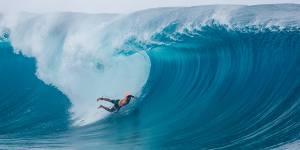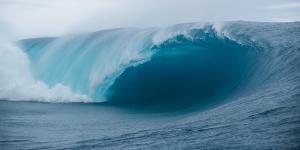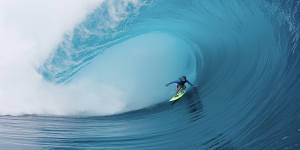Just why is Teahupo’o – loosely translated to “place of skulls” in the local Polynesian dialect – so dangerous? So perfect,petrifying,extraordinary and inimitable all in one?
The answer from Australian Jack Robinson,one of the best big-wave surfers in the world and a favourite for,brings a shudder,and a few other involuntary bodily reactions.
“Picture an eight or 10 storey building with the amount of water and volume coming in and breaking over a four-foot shallow reef,” Robinson says from within earshot of Teahupo’o,a wave that literally keeps pro surfers up at night as it hammers the razor-sharp reef.
Six-to-eight foot peaks are expected to kick off the WSL’s Tahiti Pro this weekend before forecasts of Teahupo’o potentially cranking up to double overhead (roughly twice the height of an adult) monsters next week.
The likes of Robinson and compatriots Molly Picklum and Ethan Ewing (who),bring impressive resumes to arguably the world’s most challenging wave.
They’ll all be along when the Olympics rolls into Tahiti too. So too,a collection of qualifiers who aren’t so well-versed in the Teahupo’o tango,China’s 15-year-old Yang Siqi the most notable as her nation’s first-ever Olympic surfer.
There’s every chance Teahupo’o turns out two-to-four foot,almost point break style waves for the four-day Olympics window,switching the stakes completely for the 48 men and women chasing medals.
“But it’s a straight-up gladiator pit when the waves are big,” Robinson says. “To have such a heaving,dangerous environment,and then add competition to it,it’s a bit indescribable.”

Tahitian Kauli Vaast,pictured coming unstuck at Teahupo’o in 2019,is an Olympic dark horse thanks to his local knowledge.Getty
The mechanics:Why is Teahupo’o so unique,and so dangerous?
‘Gladiator pit’ is an apt description given the concave chaos the Tahitian sea floor can generate before the wave is sucked up from below sea level.
In short,the rapid rise of said floor from deep below the surface at a 1:1 ratio (rising one vertical metre for every horizontal metre) is what creates the incredible wave face in the best prevailing swells.
The south-west swell is what really does the business at Teahupo’o throughout the autumn and winter months.
And much like Pipeline on Oahu’s north shore,Tahiti’s isolation as a comparative speck in the middle of the Pacific is where the wave’s power lies.

Swells generated by storms as far afield as the south Indian Ocean - so picture yourself on a beach in Perth,staring straight out to sea - have been tracked all the way along Australia’s southern coasts,up past New Zealand and into Teahupo’o.
And given there’s virtually nothing along that path to slow the swell down,waves can arrive with a preposterous amount of power,surge up the underwater slope and peel over and onto a reef that can have as little as 45 centimetres of water on it at low tide.
“There’s the two ledges,the inner ledge and the outer ledge,and the outside bowl,” world No.3 Picklum says. “The best place to take off changes depending on the swell,and so do the exits and the safe zones. The little reef on the inside breaks when it’s smaller - it’s really fast and a short little barrel. And it’s basically the same on the outside when it’s bigger.
“Everything is just amplified. There’s more water coming in. It feels more dangerous when it’s bigger,but there’s more water over that reef and it’s not as shallow.”
Adds Robinson:“The wave actually bends. You take off on the wave and you’re looking at the mountains. And then the wave comes off with this incredibly fat and powerful lip,you’re inside and it bends around on you so you find yourself facing a different direction. It’s just the wildest ride.”
So how do you survive,or even thrive?
“Years and years of practice,” Robinson says,having lived off Weet-Bix and eight-foot West Australian slabs for much of his childhood before.
“You’ve got to have guts for sure,” Picklum says. “Good paddle speed and a strong barrel-riding technique. But to be good at Teahupo’o,you’ve just got to go to Teahupo’o.”
Therein lies the rub. And in all likelihood when it’s pumping,the difference between a Championship Tour triumph or Olympic medal,and donating skin,or much worse to the Teahupo’o reef. Five surfers have died at the break,including big-wave expert Thierry Vernaudon and Tahitian local Briece Taerea a week before the CT event in 2000.
Robinson has been visiting Tahiti since he was 14. And as one of the better-resourced national bodies in the surfing world,Surfing Australia has been able to invest in sending Picklum over for three weeks during her last off-season.
“I probably didn’t understand that wave before,” she says. “But I copped the scariest wipeout of my life and I’m better for it. I jumped off a jet ski straight into the biggest barrel I’d ever had at 6am,I was still waking up and I got absolutely flogged with four or five more waves on the head.
“I had the ski picking me up each time and that’s when I was very,very grateful,because without them I was probably dead.”

Eye of the storm:An empty wave powers through at Teahupo’o.Getty
As Picklum notes,strange as it seems,she’s grateful for the chance to be bounced along the iconic reef. Some of her Olympic competitors - hailing from places like China,Germany,Canada and Peru,simply don’t have the luxury of lengthy training trips.
Again though,a surfer like Portugal’s Yolanda Hopkins has never surfed Teahupo’o but is highly rated for her performances in big,barrelling surf. Yang Siqi’s march to Paris 2024 was secured by in March,though there’s talk of the Chinese teen charging bigger fare during a recent trip to Indonesia.
Robinson meanwhile,is a walking contradiction - on land he’s so laid back he’s named his baby son Zen,in the water,especially when it’s heaving,he’s competitive as hell.

Tahitian local Matahi Drollet surfing a Teahupo’o monster at age 16 in 2015.Ted Grambeau
“It’ll be interesting to watch,it’s on them,” he says as diplomatically as he can of the Olympians venturing to Teahupo’o with little experience of the wave.
“We’ll see how they go. It’s just a different beast out there. It’s so thick,so powerful and perfect at the same time. You see other guys who have been on tour for a long time and they’re still a little bit nervous when they come here.
“But having the Olympics here,fans are going to see us surfing in the heaviest,most perfect waves we’ve got. I hope it’s pumping.”
Sports news,results and expert commentary..